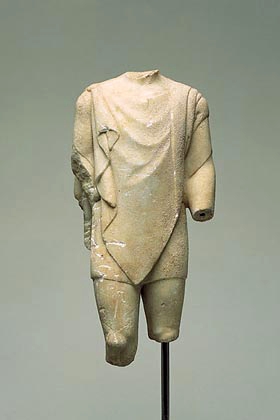George Ortiz is acknowledged as having assembled the finest private collection of antiquities in the world and Morris Associates has been fortunate to collaborate and oversee all of the associated aspects of these exhibitions in partnership with this unique collector.
The first of these were shown at the State Hermitage Museum in St Petersburg and the Pushkin Museum in Moscow. The presentation of these exhibitions in Russia formed part of a reciprocal agreement, whereby various Russian museum holdings would be lent and shown in Switzerland. The exhibit consisted of 283 objects (mainly bronze, ceramic, wood and marble), arranged in 107 displays and our extensive involvement ranged from the preliminary planning and realisation of the design, including the design and installation of the lighting structure, to the mounting of the objects at both locations.
Installation is often extremely complicated and can often present problems that require micro planning with innovative solutions. For example, the Hermitage did not have elevators, so moving objects such as the Greek Lion weighing over 1000kg required careful consideration. The eventual solution required 40 Russian soldiers to raise the object (in its crate), up three flights of a protected marble staircase on a sledge that was specifically designed for the task. The installation, within the 1500m2 Nikolaevsky Ballroom and Anti-room at the State Hermitage Museum, was not only well received by visitors, but also highly acclaimed by the art world and international press. The exhibition was attended by approximately 5,000 visitors daily for twelve weeks.
Numerous articles have been written in regard to these exhibitions. Amongst the most memorable quotes were those of Philippe de Montebello - Director of the Metropolitan Museum, 1977 to 2008 - who said of the Hermitage installation "It is the most marvellous temporary exhibition I have even seen".
"In Pursuit of the Absolute" was chosen as the title for the last exhibition in the series of the George Ortiz Collection which was shown at the Royal Academy of Arts in London at the request of Sir Norman Rosenthal the serving Secretary of Exhibitions following its success in Russia and the Altes Museum in Berlin.
The exhibition at the Royal Academy was quite different from those previously seen, as quite remarkably the room configuration lent itself not only to the specific number of objects presented, but also to the chronology of the display. One of the most striking aspects of this exhibition was how the arrangement of the exhibits allowed impressive vistas and natural object associations to be formed, as well as allowing the addition of several playful gold objects which proved to be yet another highlight.
One of the most interesting and generous reviews whilst at the Royal Academy was provided by Brian Sewell, then of the Evening Standard who wrote "The exhibition is meticulously arranged and lit", he went on "the conjunctions are astonishing" and "from such an arrangement the British Museum could well learn a lesson in display".
















